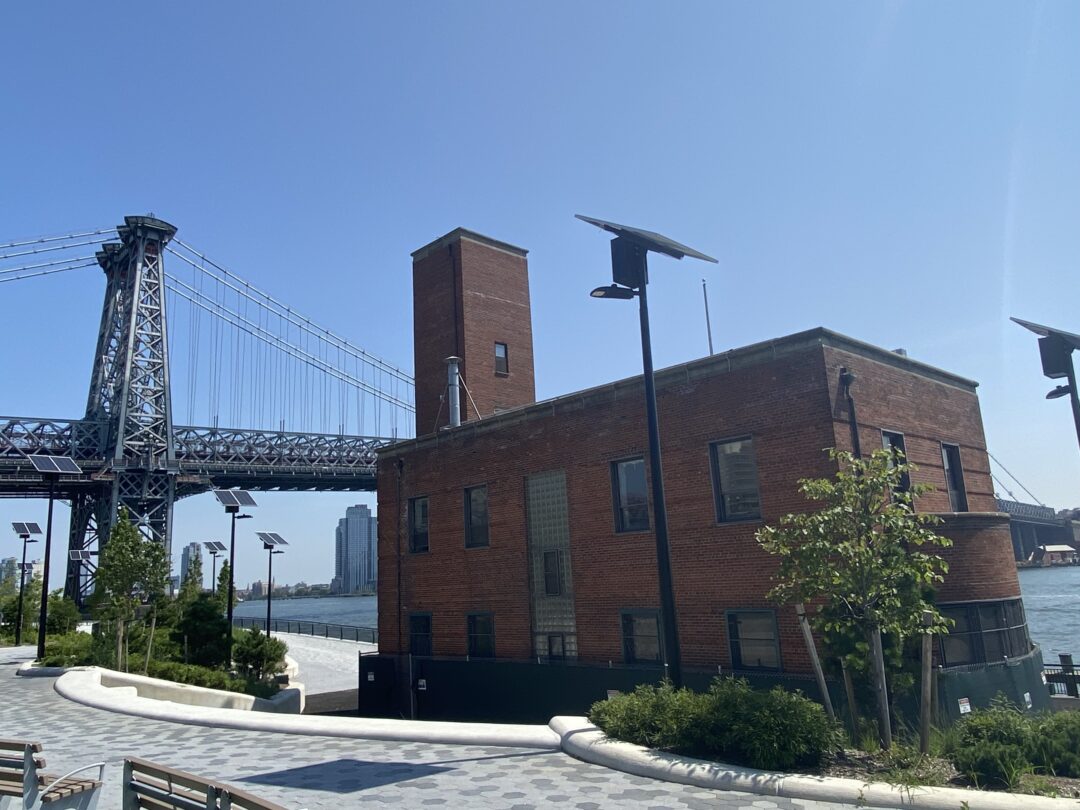
Farewell to An Old Friend: Essex Street Market
By Helena Andreyko

Early in 2019 New York City will say goodbye to a Lower East Side (LES) institution – the Essex Street Market, ending a nearly 80 year history in its current location. The Market officially opened in 1940, and consisted of four buildings, extending from Broome to Stanton. It housed a whopping 475 vendors, each paying $4.25 per week to operate a stall.
My first experience with the market was love at first sight: wooden bins of fruits and vegetables, cramped tiled stalls, the bustle of sales, and the simple elegance of the building itself with white industrial ceilings, crisscrossing pipes, and beautiful angled skylight windows. I could feel the years of history just walking in the front door.
The Market was Mayor LaGuardia’s solution to, what had become, a pushcart congestion problem. A look at any historic photo of the LES from the early 1900s will reveal streets jammed with pushcart vendors, crowded with customers eagerly searching for a good bargain. Pushcarts provided an inexpensive and self-reliant method for immigrants to make a small living, and was especially popular during the depression when jobs and money were scarce. Pushcarts became so popular, however, that the City eventually felt that it had to alleviate the massive street congestion they caused. So the City built some buildings, consolidated the vendors and, voila, the Essex Market was born.

The products sold in that early market primarily reflected the community’s Jewish and Italian immigrant population. As the neighborhood’s demographics changed in the 1950s with the influx of Latino immigrants, sales of plantains gradually replaced gefilte fish and mozzarella. Over the last 80 years the market has offered everything from spaghetti, meats, and soups, to buttons, hats, and hosiery. You can still get a shave and a cut from one of the best barbers in the City.
With the current boom in glass towers on the LES, the neighborhood is once again in flux and a major change will come to the market. The last of the original buildings will be torn down – another LES historic site discarded by the city – and the vendors moved to the ground floor of one of the new towers. Many, though not all, of the current shops will make the move, and new tony stores and restaurants will be added to the mix.
Conversations among the vendors about the move run the gambit: sadness, nostalgia, anxiety, and even excitement for a new beginning. I, for one, am sad to see the market leave its historic home, but I wish our vendors well and hope they have much success as they create a new history in their new home.
(Photo NY Public Library (upper) and NY Times (lower))
In Memory of Marie Beirne, Longtime LESPI Board Member and Preservationist
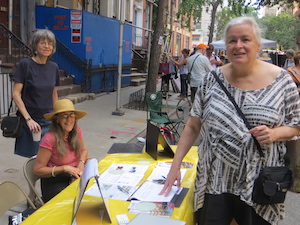
Just recently we learned of the passing of Marie Beirne, a former member of the LESPI Board of Directors. Marie was a Director from 2011 until she resigned in 2016 due to failing health, when she joined our Board of Advisers. She brought so much to our Board. She was a seasoned preservation advocate, who often produced oral histories – for City & Suburban

Homes, Stuyvesant Town / Peter Cooper Village, and the Lower East Side – to emphasize the personal aspects of landmarking. Her intelligence, passion and humor left a lasting mark on all of us. Her enthusiasm for preservation shone through in everything she did. In her own words, “The Manhattan tenant experience is like no other in America. Honoring our immigrant ancestors’ contribution to Manhattan, is an ongoing preservation effort to highlight our social, cultural, historic and architectural history.” We miss her.
Sign LESPI’s Petition for a LES Historic District!
Join more than 1,500 people who have signed LESPI’s petition for a new Lower East Side historic district below Delancey Street, in the blocks around the Tenement Museum. This is one of the city’s and country’s most important communities, due to its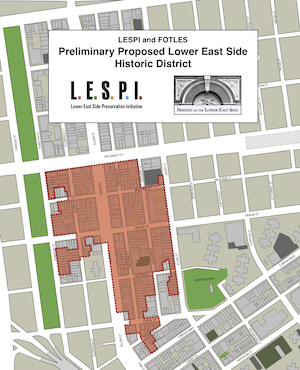
unique immigration, artistic, cultural and architectural history, which has played such a formidable role in our nation’s development. The only way to protect the historic Lower East Side from complete demolition and redevelopment is city landmarking. Sign the petition HERE!
LESPI at “Rally for our Neighborhoods”
On October 14, Human-scale NYC’s “Rally for our Neighborhoods” brought out more than 300 people, including more than 60 neighborhood, preservation and advocacy groups, to the steps of City Hall, who spoke out against overdevelopment, gentrification, and loss of historic buildings and neighborhoods.
LESPI President Richard Moses spoke on these themes, noting the
“crazy, insensitive, out-of-scale development marching through [the
Lower East Side] like Godzilla,” and the need for “landmarking to happen
very soon before the entire community becomes unrecognizable, and we
lose one of the most historically important areas of the city if not the
country.”
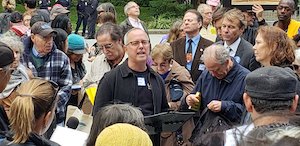
We want to especially thank Lynn Ellsworth of Human-scale NYC for organizing this important protest!
(Photo by Helena Andreyko)
LESPI T-shirts!
Support LESPI and look good doing it with a LESPI t-shirt! Proceeds benefit LESPI’s work. Only $25 (including shipping and handling). Show your support for the East Village / Lower East Side and Chinatown by purchasing HERE

You’re contribution will help us protect our historic streetscapes!
Join LESPI for 2019
Your $20 membership dues help us work to preserve the historic East Village / Lower East Side. Or donate more: all donations are tax deductible as allowed by law. See HERE to donate. Thank you!
Support LESPI!
Donate!
Please donate to LESPI to help us in our work to preserve the historic East Village / Lower East Side! To donate:
Or you can write a check to “FCNY/LESPI” and mail it to LESPI, c/o Neighborhood Preservation Center, 232 East 11th Street, New York, NY 10003. All donations are tax deductible as allowed by law.
Volunteer!
We’re looking for people to help with outreach, people with specialized skills and experience, monetary donations, and any other assistance that can help further our mission. We’d very much appreciate your help in our campaign to preserve the East Village / Lower East Side and hope to hear from you in the near future. Contact us at info@lespi-nyc.org.
Stay in Touch!
Go to “Lower East Side Preservation Initiative†on Facebook and check out our site! If you click the “Like†button you’ll receive periodic preservation, history and architectural updates for the LES/EV. You’ll also be showing support for our cause!
East Village: Lens on the Lower East Side
“East Village: Lens on the Lower East Side,†now in its third printing, is a wonderful compilation of contemporary photographs by photographers whose professional roots are in the East Village, and a beautifully written history by author Marilyn Appleberg.
Photographs by Don Freeman, Alan Gastelum, George Hirose, Onno de Jong, Marlis Momber, and Ciaran Tully show that the historic East Village is a vital, modern community, where the historic architecture and beautiful, century-old streetscapes foster creativity, self-expression and joy, as well as a diversity of people, businesses and institutions.

Available at McNally Jackson Books at 52 Prince Street and The Source at 331 E 9th Street.
About LESPI
LESPI is a grass roots, all-volunteer 501(c)(3) not-for-profit corporation in NY State formed in 2007 to urge the NYC Landmarks Preservation Commission to designate as historic districts intact portions of the East Village / Lower East Side. Our strategy includes documenting and mapping the historic streetscapes, starting with the East Village, Lower East Side below Houston Street, and Chinatown, and rallying community residents, city officials and the LPC to effect landmark designation. LESPI is a not-for-profit corporation in the State of New York. Our fiscal sponsor is Fund for the City of New York.
Contact us by email at info@lespi-nyc.org, or use the form through our web site lespi-nyc.org, or by mail at LESPI, c/o Neighborhood Preservation Center, 232 East 11th Street, New York, NY 10003.
The NYC Landmarks Commission Has New Preservationist Chair
In September preservationists celebrated the news that the Mayor had appointed Sarah Carroll as Chair of the NYC Landmarks Preservation Commission (LPC). Ms. Carroll, a 24 year veteran of the agency, has extensive professional experience and educational background in historic preservation, and is the first preservationist Chair of the LPC since the 1990s. (Full disclosure: Ms. Carroll and LESPI President Richard Moses were colleagues at the LPC during the 90s).

After campaigning for the appointment of a preservationist LPC Chair to fill the empty position, LESPI enthusiastically supported Ms. Carroll’s appointment during the City Council confirmation process. During the Council hearing on the appointment, Ms. Carroll stated, “it’s very important to me that we do seek to protect areas and properties that reflect the diversity of this rich city.” Councilmember Margaret Chin asked Ms. Carroll to review the agency’s work on a Lower East Side Historic District (first proposed by LESPI and FOTLES), and noted that the neighborhood is “rich with a living history of working families from every corner of the globe.”
We look forward to working with Ms. Carroll on our Lower East Side historic district proposal and other important LES preservation initiatives.
(Photos: NYC LPC)
LESPI Publishes 2nd “Lens on the Lower East Side” book on Historic Chinatown
LESPI is proud to announce the publication of our photo journal essay on NYC’s historic Chinatown, called Chinatown: Lens on the Lower East Side. The

book showcases wonderful photographs from six local professional photographers whose work has a boldly contemporary aesthetic, accompanied by a brief history of Chinatown with text in English and Chinese.
Chinatown: Lens on the Lower East Side’s contemporary photographs capture the spirit of today’s Chinatown residents, workers, and visitors against a backdrop of the area’s unique historic streetscapes. The photographs show how Chinatown’s historic streetscapes are not only beautiful, but also serve to enrich and enliven everyday modern life.
This is LESPI’s second book in a series on the neighborhoods of the historic Lower East Side; the first was “East Village: Lens on the Lower East Side,” published in 2015 and now in its 3rd printing. A third book on the Lower East Side from Houston to Canal Streets is currently in development.

We want to thank Chinatown: Lens on the Lower East Side’s contributors: writer Yi Zhao, translator Karen Low, lead photographer Corky Lee, and photographers Edward Cheng, Jook Leung, Ka-Man Tse, An Rong Xu, and Karen Zhou.
The book is intended to show the need to protect Chinatown’s historic core – between Canal, Worth, Baxter and the Bowery – before we lose this incredible neighborhood to demolition and overdevelopment.
The book is currently available at McNally Jackson Books at 52 Prince Street.
Landmark the Lefkowitz Building!
The majestic Art Deco style Louis J. Lefkowitz State Office Building at 80 Centre Street narrowly escape destruction last month, when the city administration backed away from plans to construct a tower on top of it to house a jail.
This grand civic building in Manhattan’s civic center and at the border of Chinatown was designed by Sullivan Jones and William Haugaard – who both served as New York State Architects – and constructed in 1928-30. Its granite facade and elegant detailing, including eagles, rosettes and lions heads, impart a sense of grandeur fitting to its role housing government offices, including the New York City Marriage Bureau, and harmonize beautifully with its neighboring civic buildings.
The building remains vulnerable to demolition or insensitive alteration – only city landmarking can truly protect it. LESPI supports designating the building an Individual Landmark – stay tuned as we move ahead on this campaign.
(Photos Wikapedia (upper) and Karlin Chan (lower))
LESPI East Village LGBT Historic Sites Tour
On Sunday November 5 cultural historian Laurence Frommer led a fascinating tour of East Village LGBT historic sites for LESPI. He took us to the homes and work places of famous writers and artists, to theaters which have produced the work of LGBT playwrights, and to legendary but now-gone bars and social venues, dating back to the 1890s.

We saw a lot of great sites! A few examples:
– Andy Warhol’s first home in NYC on St Mark’s Place
– the former home of poet W.H. Auden and his lover Chester Kalman on St. Mark’s across from Theatre 80
– the former site of Brownies on Avenue A where the drag king phenomenon of the 1990s really took off
– the former site of Limbo Lounge on East 10th Street where, during
the 1980s, actor and playwright Charles Busch did some of his early
work, including Vampire Lesbians of Sodom
– the former Yiddish Arts Theater on Second Avenue, which was a
famous drag club in the 1950s and, on the upper floors, the 1970s home
to photographer Peter Hujar and artist David Wojnarowicz
– Pareis Hall, an 1890s gay bar on the Bowery (in the late 19th and
early 20th century bars for gay man proliferated under the elevated
train on the Bowery)
– East 4th St. Arts Block: birthplace of many LGBT theater and
performance pieces, including by Harvey Fierstein, Maria Irine Fornes,
Edward Albee, Elizabeth Swados, and countless other LGBT theater folk,
and where Alla Nazimova, who brought the Stanislavski system acting to
the USA, did some of her first performances in America, produced by
political activist Emma Goldman.

The attendees, several of whom were artists and performers with professional roots in the area going back to the 1980s, added their own experiences. What a wonderful fall afternoon!
(Photos by Richard Moses (upper) and David Jarrett (lower)).
Municipal Archives’s 1940s “Tax Photograph” Collection Now Online!
Phenomenal news for anyone who loves NYC architecture, history, and historic preservation: the NYC Municipal Archives’s 1940s “tax photograph” collection

documenting every building in the city at a “moment” in time is now online, 720,000 images total. You can also browse from a wealth of other images from the Archives.
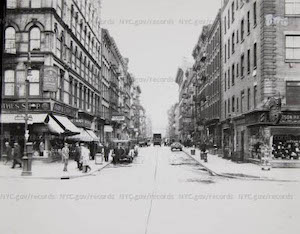
See HERE to search for any property in the 5 boroughs. Enjoy!



